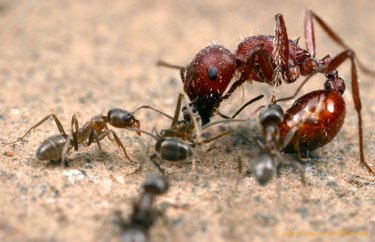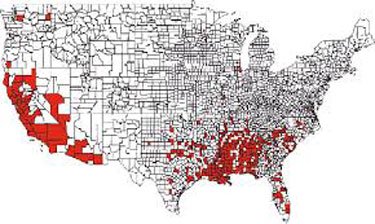Largest Animal War in History
Ants, Linepithema humile, Natural History, Quora, War

An Argentine ant (Linepithema humile) attacks a much larger fire ant (Solenopsis invicta).
Every now and then there is a good question and answer on Quora. Someone asked: “Do animals fight wars and if so what was the largest war?”
Zoologist Suzanne Sadedin replied:
The largest war in animal history — in fact, by numbers the largest war in history — is going on right now.
Once upon a time there was a tiny brown ant who lived by a swamp at the end of the Paraná River in Argentina. Her name, Linepithema humile, literally means “humble†or “weakâ€. Some time during the late 1800s, an adventurous L. humile crept away from the swamp where giant river otter played and capybaras cavorted.
She stowed away on a boat that sailed to New Orleans. And she went to war.
At home in the Paraná delta, L. humile nests would ferociously defend themselves from other nests, both of their own species and other kinds of ant. It was a life of never-ending territorial skirmishes, where nobody could really get ahead. When two L. humile met, they would flick their antennae over each others’ bodies, tasting the combination of hydrocarbons on their skin. This flavor would tell them whether the stranger belonged to the same nest. If she tasted familiar, she would be recognized as a sister. She would be gently stroked, offered food and welcomed into the nest. But if the flavor were not recognized, the ants would try to kill each other.
In New Orleans, something changed. L. humile, invading the United States, spread like wildfire. Instead of forming discrete, competing colonies, they behaved as a united army. They would brutally attack ants of other species, but welcome every L. humile as a long-lost sister in arms. Like L. humile in Argentina, other species of ants in the US must defend their territories against their own species. This gives the cooperative L. humile a huge strategic advantage; they waste neither lives nor energy on fighting with their own kind, but focus ruthlessly upon species-level conquest. Though individually tiny, they can swarm over native ants many times their size.
The supercolony grew to cover most of the United States. Then it spread to England, Europe, Japan, Australia and New Zealand. L. humile is now abundant on every continent except Antarctica, and wherever she goes, she slaughters native ant species.
How did she do this? Did inbreeding reduce the diversity of hydrocarbons on the ants’ skin, such that they no longer saw one another as enemies, but as sisters? Did natural selection tone down L. humile’s territorial instincts to suit their environment, so they would react aggressively only to the strong stimulus of another species? It seems likely both mechanisms were involved.
Things have not been perfect. Near San Diego, a schism formed, and a separate supercolony was created. The battlefront extends for miles; some 30 million ants die there every year. Another super-colony has formed in Catalonia. Perhaps as L. humile eliminates her competitors, her alliance will fracture entirely into squabbling tribes. But for now, from Europe to the United States, all the way to New Zealand, a global megacolony still persists, consisting of around 1 trillion individuals: a humble brown ant united in war against every other ant alive.
People always talk about the meek inheriting the earth. In L. humile’s case, it’s clearly working.
————————————-




